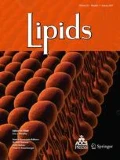Abstract
The fluorescent substances produced by the reaction of linoleic acid hydroperoxides (LOOH) with ca. 20 different amino acids and bovine serum albumin (BSA) were studied. Only the amino acids, lysine, glycine, arginine, histidine and phenylalanine, gave products with strong fluorescent properties. Products of lysine had a fluorescence intensity of ca. 10 times those of glycine and 100 times those of phenylalanine. The N-acylation of amino acids greatly reduced the fluorescence of the products of the reaction except lysine and arginine. The fluorescence of the products of the reaction of LOOH with N-acetyl BSA was only ca. 25% of the control BSA under the same conditions. It appeared that the substances formed from the reaction of LOOH with BSA were crosslinked polymers as evidenced by column chromatography and polyacrylamide gel electrophoresis. These products were insoluble in common organic solvents and their fluorescent intensities correlated well with the thiobarbituric acid (TBA) test. These observations appear to be highly important in the formation of lipofuscin substances, particularly those associated with the aging pigments which accumulate during aging in mammalian tissues.
Similar content being viewed by others
References
Tappel, A.L. (1973) Fed. Proc. 32, 1870–1874.
Fletcher, B.L., Dillard, C.J., and Tappel, A.L. (1973) Anal. Biochem. 52, 1–9.
Csallany, A.S., and Ayaz, K.L. (1976) Lipids 11, 412–417.
Taubold, R.D., Siakotos, A.N., and Perkins, E.G. (1975) Lipids 10, 383–390.
Shimasaki, H., Nozawa, T., Privett, O.S., and Anderson, W.R. (1977) Arch. Biochem. Biophys. 183, 443–451.
Shimasaki, H., Privett, O.S., and Keane, W.F. (1978) Radiat. Res. 74, 393–404.
Shimasaki, H., Ueta, N., and Privett, O.S. (1980). Lipids 15, 236–241.
Phillips, F.C., and Privett, O.S. (1981) J. Am. Oil Chem. Soc. 58, 590–594.
Siakotos, A.N., Watanabe, I., Saito, A., and Fleisher, S. (1970) Biochem. Med. 4, 361–375.
Siakotos, A.N., Goebel, H.H., Patel, V., Watanabe, I., and Zeman, W. (1972) in Advances in Experimental Medicine and Biology (Volk, B.W., and Aronson, S.M., eds.) Vol. 19, pp. 53–61, Pergamon Press, New York, NY.
Privett, O.S., Lundberg, W.O., and Nickell, E.C. (1953) J. Am. Oil Chem. Soc. 30, 17–21.
Roosdorp, N., Wann, B., and Sjoholm, I. (1977) J. Biol. Chem. 252, 3876–3880.
Maizel, J.V. (1971) in Methods in Virology (Maremorosch, K., and Koprowsky, H., eds.) Vol. 5, p. 188, Academic Press, New York, NY.
Shimasaki, H., Privett, O.S., and Hara, I. (1977) J. Am. Oil Chem. Soc. 54, 119–123.
Yagi, K. (1976) Biochem. Med. 15, 212–216.
Author information
Authors and Affiliations
About this article
Cite this article
Shimasaki, H., Ueta, N. & Privett, O.S. Covalent binding of peroxidized linoleic acid to protein and amino acids as models for lipofuscin formation. Lipids 17, 878–883 (1982). https://doi.org/10.1007/BF02534582
Received:
Issue Date:
DOI: https://doi.org/10.1007/BF02534582




